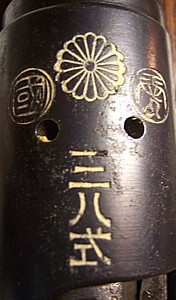
- Type 99 arisaka serial numbers serial#
- Type 99 arisaka serial numbers plus#
- Type 99 arisaka serial numbers series#
The HOWA 5:56 will replace the currently currently in service Howa Type 89 assault rifle.
Type 99 arisaka serial numbers serial#
The serial number, 16776, is on the left side of the receiver. The JGSDF selected a lighter, modern assault rifle, the Howa Type 89, in 1989. In fact, the system would be directly responsible for the design of the hugely successful Soviet Kalashnikov AK-47 assault rifles that are still found - and in many cases copied - throughout the world. MODEL 99 JAP 7.7 CALIBER HAS BEEN SPORTERIZED, Pre-Owned - Arisaka Bolt Action 7.7x58 23, "Nagoya Arsenal Type 99 7.7 Japanese (R30318). The Mauser 98k was the standard issue rifle for the German army, and production costs at the beginning of the war were around $28 per unit.
Type 99 arisaka serial numbers series#
WW2 Japanese Type 99 Arisaka chambered in 7.7 Jap w/ Intact Mum ** Kokura Arsenal Series 21 **, Jinsen Arsenal Rare Pre Production Type 38 Arisaka Rifle, Japanese Arisaka Rifle Type 99 w/Navy Bayonet, Pre-Owned - Arisaka Type 99 Bolt 7.7x58 26" Rifle, Japanese ~ Type 26 ~ 9mm Japanese Revolver. It was adopted by the Swiss Army in 1990 and Swiss Army soon introduced a shorter carbine version, the SG 551 and a few years later in 1998 with an even. I have attached pictures, please give me your thoughts on this rifle, I'm not interested in selling but just looking for an accurate history.Here's a list of translations. I also have a type 30 bayonet which I thought went with this rifle but there is literally no place to attach it because of the short stock and lack of a notch. From the markings on the sides of the serial number, I believe it was made in either Koishikawa or Kokura. I then thought it was a last ditch effort rifle but it has anti-aircraft sites, a serial number, removed mum, and the tall shielded front site.
Type 99 arisaka serial numbers plus#
Plus I know that he never used the rifle in his time back in the US after the war. Initially I thought my grandpa maybe built his own stock, as he was a carpenter but this stock is old showing much wear and tear. The stock is much shorter than anything else I've seen on the 38, carbine, sniper or other type 99's. It is definitely a type 99 due to the markings on the receiver/barrel but it has a completely different stock.

This Arisaka seems different than all the others I've seen though. Apparently he brought it back with him from his time in the pacific as most guys did. Today I actually had to make a post because I need a little help in regards to my grandpa's arisaka type 99. Hey guys, I've been reading information from this site for some time now.

These could just be manufacturing differences from year to year I suppose.Īpologies for the camera phone quality and thanks for any insight! Does this describe what I have? I have seen pictures off 99s that look a bit different than mine where the barrel and receiver meet. I suppose it could have been ground as well, but this seems unlikely to me.Īlso, I have read about a screw joint between the receiver and barrel for the paratrooper issued rifles.


What is confusing is the lack of any symbols preceding the serial number. In any case, I've always thought it was a very interesting piece.įrom what I can gather via online resources, it seems to be a Type 99 Nagoya. This one is far from being a highly sought-after museum quality collector's item, seeing as how the flower has been ground off, the barrel stock chopped and modified and a huge NRA seal stamped in the side of the stock. I saw several people posting pictures of their Japanese rifles and thought I would share as well. Hi, was doing some research on a family rifle and came across your site.


 0 kommentar(er)
0 kommentar(er)
